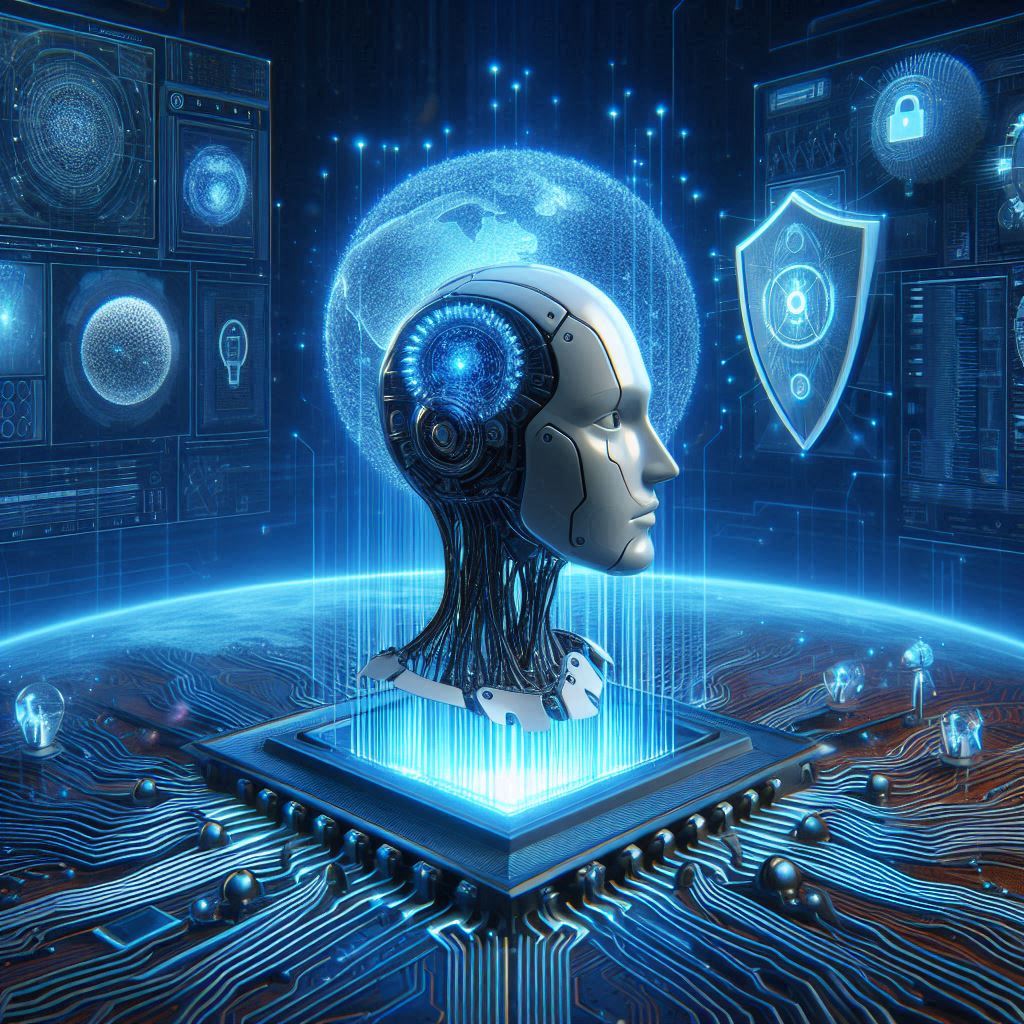As cyber threats evolve and grow more complex by the day, it’s clear that traditional security measures are struggling to keep up. But fear not! Enter Artificial Intelligence (AI) – a true game-changer in the realm of cybersecurity. AI’s remarkable ability to scrutinize massive volumes of data, learn from past incidents, and swiftly adapt to new threats makes it an indispensable ally for modern security teams. Join us on this thrilling exploration of how AI is single-handedly revolutionizing cybersecurity, empowering us to detect threats more effectively, respond to incidents with greater agility, and ultimately fortify our digital world. Brace yourself for a cyber-revolution!
Enhancing Threat Detection
One of the most exhilarating advantages of AI in cybersecurity is its remarkable ability to uncover threats that would otherwise lurk in the shadows. AI systems tirelessly sift through colossal amounts of data from diverse sources, in real-time, unveiling patterns and anomalies that signal potential security breaches. By harnessing advanced algorithms, AI not only identifies known threats, but also anticipates and adapts to new, evolving cybersecurity risks. Thanks to machine learning algorithms, these systems learn from historical data, constantly honing their threat detection prowess and enhancing their accuracy and effectiveness with each passing moment. This adaptability is paramount in the ever-changing landscape of cyber threats, equipping organizations with a proactive defense mechanism against sophisticated attacks.
Pattern Recognition and Anomaly Detection
AI’s incredible prowess lies in its ability to uncover patterns within data, a critical skill for uncovering any abnormal behavior that could indicate a cyber attack. Take, for example, an AI-driven system diligently monitoring network traffic and highlighting any irregular activity, such as sudden spikes in data transmission or attempts to access from unfamiliar IP addresses. These deviations frequently precede security breaches, providing organizations with a vital window to take preemptive action. Through its adept analysis of immense data sets, AI can spot subtle deviations from the norm and continually evolve and learn from new information, bolstering its detection capabilities. This autonomous capacity for adaptation and improvement positions AI as an indispensable asset in staying one step ahead of emerging cyber threats. Moreover, AI’s swift response capabilities empower organizations to rapidly address potential risks, nipping potential breaches in the bud before they can escalate into more severe security incidents.
Adapting to New Threats
Cyber threats loom large in today’s interconnected world, posing a formidable challenge as attackers constantly concoct new methods to evade security measures and wreak havoc. Within this dynamic landscape, the indispensability of AI comes to the forefront, fueled by its remarkable machine learning capabilities. Through the strategic harnessing of AI, organizations not only keep pace but surge ahead, empowering their security measures to swiftly adapt and effectively counter emerging threats. Driven by continuous learning, AI systems glean insights from past attacks, discern patterns, and refine their threat detection models, ensuring a proactive stance in cybersecurity. This adaptability stands as a pivotal factor in maintaining the resilient and potent nature of AI systems, fortifying an unwavering defense even amidst the continuously shifting threat landscape.
Automated Threat Intelligence
AI is absolutely indispensable when it comes to bolstering cybersecurity measures. With its perpetual surveillance and thorough analysis of diverse datasets, AI stands as an unwavering guardian against cyber threats. By harnessing sophisticated algorithms, AI adeptly connects the dots across various sources, including threat databases, security feeds, social media platforms, and the mysterious realms of the internet. This holistic approach empowers AI to discern patterns, pinpoint anomalies, anticipate potential threat vectors, and provide invaluable guidance to organizations. Consequently, businesses are empowered to strengthen their security defenses with proactive strategies and real-time response mechanisms, effectively neutralizing the impact of cyber threats.
Automating Routine Security Tasks
Routine security tasks can be incredibly draining and time-consuming for IT and security teams. The never-ending cycle of monitoring logs, scanning for vulnerabilities, and conducting security audits can easily overwhelm human resources. But fear not, because AI is here to revolutionize the way we approach security! By harnessing the power of AI-driven tools, we can automate these repetitive processes, liberating our skilled experts to tackle more intricate and strategic security issues. With AI at the helm for monitoring, analysis, and response, organizations can bolster their security defenses and empower their teams to proactively combat advanced cyber threats. Embracing automation not only ramps up operational efficiency, but also dramatically reduces the risk of human error, a critical factor in security breaches. This proactive stance not only saves precious time and resources, but also equips organizations to foresee and mitigate emerging security risks. It’s time to let AI unleash a new era of security excellence!
Enhancing Incident Response
When a security incident strikes, every second counts. AI serves as the beacon of hope in incident response, offering real-time analysis and automated mitigation strategies. By harnessing the power of machine learning algorithms, AI-driven systems rapidly assess the extent of an attack, pinpoint affected systems, and suggest or implement measures to contain and resolve the breach. These systems maintain a vigilant watch over network traffic, behavioral patterns, and system logs, proactively detecting anomalies and potential threats. Furthermore, AI plays a pivotal role in dissecting the root cause of incidents, bolstering overall security posture by learning from past events and adapting to the ever-changing cyber landscape.
Real-Time Analysis and Mitigation
AI’s remarkable capacity to swiftly analyze extensive datasets in real-time is absolutely invaluable, particularly in the midst of an incident. Its ability to connect events across diverse systems provides a comprehensive view of the attack, empowering security teams to mount more effective responses. What’s more, AI can take on the burden of automating certain response tasks, such as isolating compromised systems or applying patches to vulnerable software. By harnessing the power of machine learning algorithms, AI can continuously learn and adapt to new types of threats, significantly enhancing its ability to detect and mitigate security risks in dynamic and complex environments. This adaptability enables AI to stay one step ahead of evolving cyber threats, offering organizations a proactive defense strategy. Furthermore, AI’s unparalleled capacity to rapidly identify anomalies and suspicious patterns within vast amounts of data allows security teams to prioritize and focus on the most critical threats, thereby optimizing their resources and response efforts.
Proactive Threat Hunting
AI-driven threat hunting tools represent the cutting edge of cybersecurity defense, harnessing the power of advanced machine learning algorithms to fearlessly scour an organization’s infrastructure for vulnerabilities. Through the relentless analysis of diverse data sources and the continuous adaptation to emerging threats, these tools stand ready to proactively pinpoint known weaknesses, foresee potential exploits, and furnish invaluable insights to security teams. This proactive stance empowers organizations to swiftly confront and neutralize security concerns before they fall prey to malicious attackers, thereby fortifying their overall cybersecurity stance and safeguarding their invaluable data and resources.
Monitoring User Behavior
Insider threats, whether deliberate or unintentional, represent a grave danger to organizations. AI becomes the vigilant guardian, constantly scrutinizing user behavior to unearth any hint of wrongdoing. Through meticulous analysis of access and usage patterns, AI systems uncover aberrant activities deserving further scrutiny. This proactive stance facilitates early detection of potential breaches and prompt implementation of preventive measures. What’s more, AI assists in crafting a detailed profile of each user’s normal behavior, enabling the system to swiftly pinpoint deviations with utmost precision. Additionally, machine learning algorithms continuously adapt to the ever-evolving strategies and tactics of malicious entities, bolstering the system’s prowess in outmaneuvering advancing insider threats.
Continuous Monitoring and Rapid Response
AI is the vigilant guardian that never sleeps, always on the lookout for potential threats and ready to sound the alarm at a moment’s notice. This rapid response power significantly shrinks the time window for attackers, curbing the potential harm from a security breach. Through the power of advanced machine learning, AI delves into data to spot trends and patterns, preemptively identifying vulnerabilities and bolstering an organization’s overall security stance. Moreover, AI takes on the mundane security tasks, freeing up human teams to tackle more intricate issues and strategic security planning. This proactive, adaptable approach is absolutely essential in the ever-changing realm of cyber threats, offering a crucial edge in combating emerging risks.
Improving Software Security
AI stands as an invaluable guardian in the realm of software development, ceaselessly scouring code for vulnerabilities and looming threats. With its advanced analytical prowess, AI not only flags security flaws but also offers proactive suggestions for fortification. By harnessing the power of machine learning, AI can adapt and grow in lockstep with evolving security challenges, empowering developers to proactively tackle potential risks. This iterative process births applications that are more resilient and secure, serving as stalwart protectors of sensitive data and formidable deterrents against cyber threats.
Personalized and Context-Aware Security Measures
AI empowers the development of personalized and context-aware security measures through the utilization of cutting-edge algorithms and machine learning techniques. By delving into the distinctive traits and actions of individual users and systems, AI can customize security protocols to effectively fend off specific threats. This proactive approach facilitates real-time adjustment to evolving security risks, bestowing a dynamic defense mechanism that is alert to the constantly shifting cybersecurity terrain. Furthermore, AI’s capacity to analyze vast amounts of data enables the identification of irregularities and patterns that may elude traditional security systems, elevating overall threat detection and mitigation capabilities.
Ethical Considerations and Managing False Positives
Despite its undeniable benefits, the use of AI in cybersecurity demands meticulous management to sidestep issues like false positives and ethical dilemmas. It is imperative to guarantee that AI systems are transparent, accountable, and equitable in order to uphold trust and efficiency in security operations. This entails instituting robust governance frameworks and conducting regular audits of AI algorithms to mitigate biases and errors. Furthermore, organizations must offer comprehensive training to cybersecurity professionals to adeptly harness AI tools and decipher their findings. Additionally, establishing explicit guidelines for the ethical use of AI in cybersecurity is crucial in preventing the potential exploitation of potent technology for nefarious purposes. Embracing these measures will not only elevate the overall security posture but also uphold the integrity and ethical standards of the cybersecurity industry.
Conclusion
AI is revolutionizing cybersecurity, empowering organizations with cutting-edge tools and capabilities to detect, prevent, and swiftly respond to threats like never before. Through the power of AI, businesses can construct robust defenses, proactively combat evolving threats, and safeguard their digital assets with unwavering dedication. As AI technology progresses, its significance in cybersecurity will only intensify, marking the dawn of a groundbreaking era of intelligent and adaptive defense.
Please subscribe to our posts at www.AToZOfSoftwareEngineering.blog.
Follow our podcasts and videos available on YouTube, Spotify, and other popular platforms.
Have a great reading, viewing, and listening experience!





























Leave a comment